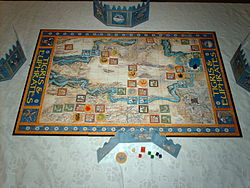- Tigris and Euphrates
-
For the Middle East river system, see Tigris–Euphrates river system.
Tigris and Euphrates Designer(s) Reiner Knizia Publisher(s) Hans im Glück Players 2–4 Age range 12+ Setup time 5 minutes Playing time 90 minutes Random chance Low Skill(s) required Strategic thought Tigris and Euphrates is a German strategy board game designed by Reiner Knizia and first published in 1997 by Hans im Glück in German (as Euphrat und Tigris). Before its publication, it was highly anticipated by German gamers hearing rumors of a "gamer's game" designed by Knizia. Tigris and Euphrates won first prize in the 1998 Deutscher Spiele Preis. A card game version was released in 2005.
The game is set as a clash between neighboring dynasties at the dawn of civilization. The game is named after the rivers Tigris and Euphrates in the region now called the Middle-East. The rivers together formed natural borders for an area which harboured several grand ancient civilizations, including Sumer, Babylonia, and Assyria. The Greeks called this area Mesopotamia, which literally means "between the rivers".
Gameplay
The game can be played by 2, 3 or 4 people. The play offers both tactical and strategic objectives. As with many games, short term objectives gain prominence when more players participate, as players have less chance to follow up on previous moves. Luck plays a role, as players draw tiles from a bag, but it is seldom decisive. Players may selectively discard and redraw their tiles at the cost of one "action point", of which each has two per turn. The game does not use dice.
The board is a map of the two rivers, marked with a square grid. There are four types of tiles with corresponding leaders: temples and priests (red), farms and farmers (blue), markets and merchants (green) and settlements and kings (black). The game starts with ten isolated temple tiles already placed on the board. Players play tiles and leaders onto the board, creating and expanding regions and kingdoms. Monuments are built on the board when four tiles of the same color are played into a square pattern.
Two leaders of the same type can not coexist in the same kingdom. Internal conflicts are caused by players adding a second leader of a type to a kingdom. External conflicts are caused by players playing tiles to merge two existing kingdoms.
During the game, players collect points in each of the four colors as a result of playing tiles, resolving conflicts and controlling monuments. After the final round each player sorts his or her points by color, including any "treasures" which they have acquired, which count as any color the player wishes. In order to limit specialization the player with the most points in their weakest category wins.
For example:
- Alice has 6 black, 8 red, 12 green and 12 blue points; thus has a score of 6.
- Bob has 9 black, 10 red, 7 green and 15 blue points; thus has a score of 7.
- Charlie has 14 black, 14 red, 5 green and 20 blue points; thus has a score of 5.
Players must balance their scoring and avoid overspecializing. Knizia later used this mechanism as the basis for Ingenious.
External links
- Tigris and Euphrates and the card game version at BoardGameGeek
- Free, licensed online version at GameTable Online
Preceded by
LöwenherzDeutscher Spiele Preis
1998Succeeded by
TikalCategories:- Deutscher Spiele Preis winners
- Historical board games
- Reiner Knizia games
- Tile-laying board games
- Hans im Glück games
- Mayfair Games games
Wikimedia Foundation. 2010.

